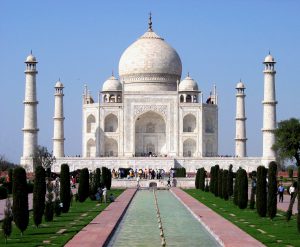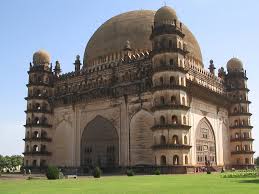Subject: History Category: Art and Culture Topic: Some Aspects of Indo-Islamic Architecture – Part II
NCERT notes on important topics for the UPSC civil services exam preparation. These notes will also be useful for other competitive exams like banking PO, SSC, state civil services exams and so on.
Indo-Islamic Architecture – Part II (UPSC Notes):- Download PDF Here
Aspirants would find this article very helpful while preparing for the UPSC 2021.
| Candidates can enhance their UPSC exam preparation by attempting UPSC Previous Years Question Papers now!!
To complement your preparation for the upcoming exam, check the following links: |
Architecture in Mandu, Madhya Pradesh
- Mandu is located 60 miles from Indore in Madhya Pradesh.
- The city is at an elevation of 2000 feet overlooking the Malwa Plateau to the north and the Narmada Valley to the south.
- It was constantly occupied by the Parmara Rajputs, Afghans and Mughals because of its natural defence.
- It was the capital of the Ghauri Dynasty (1401 – 1561) founded by Hoshang Shah.
- Great example of the medieval provincial style of art and architecture.
- It has many official and residential pleasure palaces, mosques, artificial reservoirs, pavilions, baolis, embattlements, etc.
- Most structures have arched pavilions, and are light and airy, so that they do not retain heat.
- Local stone and marble were used.
- Great example of architectural adaptation to the environment.
- Royal Enclave: Set of romantic buildings built around 2 artificial lakes.
- Hindola Mahal
- Audience hall of the Sultan
- Resembles a railway viaduct bridge with its large buttresses to support the walls
- Batter was used to give the impression of swinging (hindola) walls
- Jahaaz Mahal
- Two-storeyed ship-palace
- Built between 2 reservoirs
- Has open pavilions, balconies and a terrace
- Built by Sultan Ghiyasuddin Khilji possibly for using as his harem
- Had a terrace swimming pool
- Rani Rupamati’s double pavilion
- Baz Bahadur’s palace
- Asharfi Mahal – a madrassa
- Hoshang Shah’s tomb
- Example of the robustness of Afghan structures
- Majestic structure with a beautiful dome
- Has marble jail work, courts, porticos and towers
- Also has lattice work, toranas and carved brackets
- Jama Masjid
- Has a grand gateway and a squat dome
- Building is faced with red sandstone
- Mihrab has a lotus bud fringe
- Qibla Liwan is supported on carved brackets
Aspiring Civil Services candidates can go through Some Aspects of Indo-Islamic Architecture – Part I on the linked page.
Taj Mahal

- Built by Mughal Emperor Shah Jahan in memory of his wife Mumtaz Mahal.
- Built from 1632 and took almost 20 years to complete.
- Built by 20000 specialised workers.
- It is a mausoleum.
- It has a simple plan and elevation.
- One of the most famous architectural marvels of India worldwide.
- The structure is breathtakingly symmetrical.
- Made of white marble brought from the Makrana Mines, Rajasthan.
- It is a UNESCO World Heritage Site.
- Its monumental gateway is made of red sandstone.
- The tomb is set in a Chahar Bagh, criss-crossed with paths and water courses, along with pools and fountains.
- The tomb is on a floor terrace. On the four sides of the terrace, there are four tall minarets which are 132 feet high each.
- The main building has a drum and a dome with four cupolas.
- Towards the west of the structure is a mosque made of red sandstone.
- Towards the east is a similar structure to maintain the balance.
- Interior arrangements of the mausoleum: crypt below, vaulted, octagonal tomb chamber above; there is a room at each angle which are all connected via corridors.
- Light comes into every corner of the building through perforated and carved jalis that are set in the arched recesses of the interior.
- A double dome helps create a void that makes the ceiling as high as the façade.
- Four types of embellishments:
- Stone carvings in high and low relief on the walls
- Marble carving onto the jalis and volutes
- Creation of arabesques with pietra dura on walls and tombstones, and geometric designs with tessellation
- Calligraphy – used in the inlay of jasper in white marble to write verses from the Quran
Candidates can check out a few articles linked below to prepare for upcoming civil services examination-
Gol Gumbad

- Location: Bijapur, Karnataka.
- Mausoleum of Muhammad Adil Shah (1626–1656), Adil Shahi Dynasty of Bijapur (1489–1686).
- Built by Muhammad Adil Shah himself.
- Tomb is a complex consisting of a gateway, a mosque, a Naqqar Khana, and a sarai within a big-walled garden.
- The building is a huge square one with a circular drum. Above the drum is a majestic dome.
- Material: dark gray basalt with decorated plasterwork.
- The whole building is over 200 feet high.
- The tomb has a square chamber.
- The dome is the largest in the world with a diameter of 125 feet and an uninterrupted floor space of 18337 square feet.
- Pendentives helped build the hemispherical masonry dome over the square base.
- The building has an impressive acoustic system with a whispering gallery where sounds get magnified and echoed multiple times.
- At the four corners of the building there are seven-storeyed octagonal spires or minarets.
- This structure is a mix of many styles including local, Timurid and Persian styles.
Indo-Islamic Architecture – Part II (UPSC Notes):- Download PDF Here
UPSC exam-related preparation materials will be found through the links given below.
Aspirants can find complete information about upcoming Government Exams through the linked article.

Comments